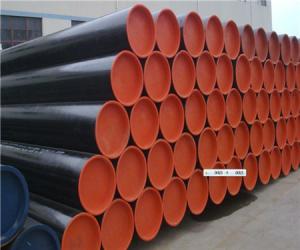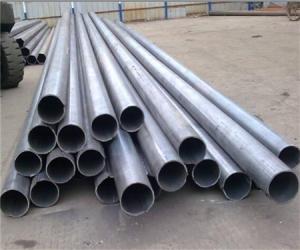Seamless Stainless Steel Pipe S31803 China Factory
- Loading Port:
- China Main Port
- Payment Terms:
- TT or LC
- Min Order Qty:
- 30 m.t.
- Supply Capability:
- 12000 m.t./month
OKorder Service Pledge
OKorder Financial Service
You Might Also Like
1、Structure of Seamless Pipe ASTM A106/53:
1.duplex S31803 stainless steel seamless pipe
2.OD:3-580MM WT:1-30MM
3.ASTM A240/789/790
4.chemical industry pipe
5.Zhejiang
2、Main Features of the Seamless Pipe ASTM A106/53:
• High manufacturing accuracy
• High strength
• Small inertia resistance
• Strong heat dissipation ability
• Good visual effect
• Reasonable price
3、Seamless Pipe ASTM A106/53 Specification:
Standard | GB, DIN, ASTM ASTM A106-2006, ASTM A53-2007 |
Grade | 10#-45#, 16Mn 10#, 20#, 45#, 16Mn |
Thickness | 8 - 33 mm |
Section Shape | Round |
Outer Diameter | 133 - 219 mm |
Place of Origin | Shandong, China (Mainland) |
Secondary Or Not | Non-secondary |
Application | Hydraulic Pipe |
Technique | Cold Drawn |
Certification | API |
Surface Treatment | factory state or painted black |
Special Pipe | API Pipe |
Alloy Or Not | Non-alloy |
Length | 5-12M |
Outer Diameter | 21.3-610mm |
Grade | 20#, 45#, Q345, API J55, API K55, API L80, API N80, API P110, A53B |
Standard | ASME, ASTM |
4、Packaging & Delivery
Packaging Details: | seaworthy package,bundles wrapped with strong steel strip |
Delivery Detail: | 15-30days after received 30%TT |
5、FAQ of Seamless Pipe ASTM A106/53:
①How is the quality of your products?
Our products are manufactured strictly according to national and internaional standard, and we take a test
on every pipe before delivered out. If you want see our quality certifications and all kinds of testing report, please just ask us for it.
Guaranteed: If products’ quality don’t accord to discription as we give or the promise before you place order, we promise 100% refund.
②How about price?
Yes, we are factory and be able to give you lowest price below market one, and we have a policy that “ for saving time and absolutely honest business attitude, we quote as lowest as possible for any customer, and discount can be given according to quantity”,if you like bargain and factory price is not low enough as you think, just don’t waste your time.Please trust the quotation we would give you, it is professional one.
③Why should you chose us?
Chose happens because of quality, then price, We can give you both.Additionally, we can also offer professional products inquiry, products knowledge train(for agents), smooth goods delivery, exellent customer solution proposals.Our service formula: good quality+good price+good service=customer’s trust
SGS test is available, customer inspection before shipping is welcome, third party inspection is no problem.
6、Seamless Pipe ASTM A106/53 Images:
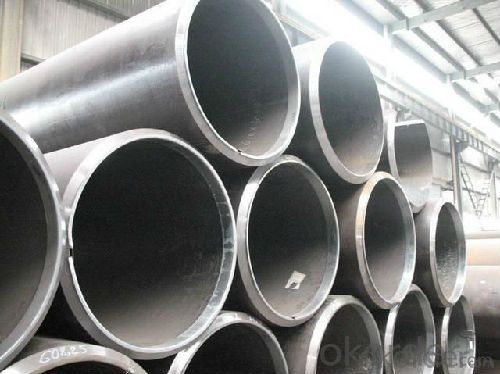
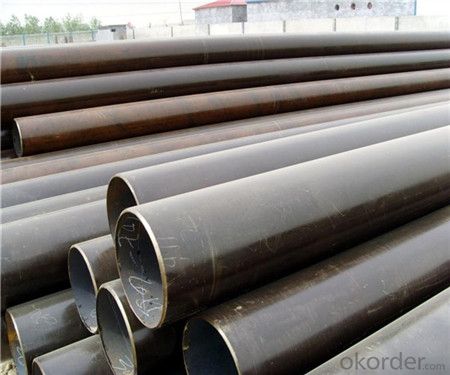
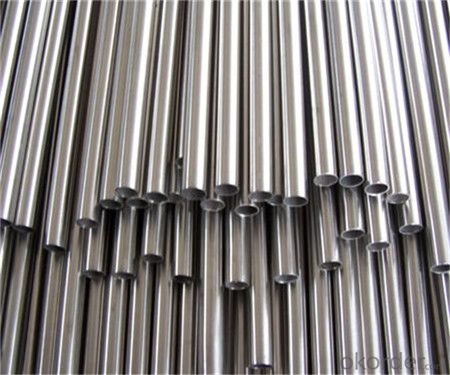
- Q:How do you calculate the flow rate in stainless steel pipes?
- To calculate the flow rate in stainless steel pipes, you can use the Poiseuille's law or the Darcy-Weisbach equation. These formulas take into account factors such as the pipe diameter, length, viscosity of the fluid, and pressure drop. By plugging in the relevant values, you can determine the flow rate of the fluid through the stainless steel pipes.
- Q:What are the different sizes available for stainless steel pipes?
- Stainless steel pipes are available in a wide range of sizes, including standard sizes such as 1/8 inch, ¼ inch, ½ inch, 1 inch, 2 inches, and larger sizes such as 6 inches and beyond. These sizes are commonly used for various applications in industries such as construction, plumbing, and manufacturing. Additionally, stainless steel pipes can also be custom-made to meet specific requirements, offering even more flexibility in sizing options.
- Q:What are the standard sizes for stainless steel pipes?
- Depending on the industry and application, the sizes of stainless steel pipes can vary. However, there are commonly used standard sizes that are widely accessible. Typically, stainless steel pipes are manufactured in nominal sizes ranging from 1/8 inch to 72 inches in diameter. These sizes are categorized using the Nominal Pipe Size (NPS) system, which refers to the approximate internal diameter of the pipe. Commonly used NPS sizes for stainless steel pipes range from NPS 1/8 to NPS 36. Additionally, stainless steel pipes are offered in different schedules, which indicate the wall thickness of the pipe. The most frequently used schedules for stainless steel pipes are Schedule 5, Schedule 10, Schedule 40, and Schedule 80. It is important to note that these standard sizes may slightly vary depending on the country or region. Therefore, it is recommended to consult the relevant standards and regulations specific to your location or seek guidance from a supplier to determine the exact standard sizes of stainless steel pipes available in your area.
- Q:What are the temperature limits for stainless steel pipes?
- The temperature limits for stainless steel pipes are dependent on the particular grade of stainless steel that is being utilized. In general, stainless steel pipes have the ability to endure high temperatures, rendering them suitable for a wide array of applications. For austenitic stainless steel grades like 304 and 316, the temperature limits typically span from -250°C to 925°C (-418°F to 1,700°F). These grades showcase outstanding resistance to corrosion and have the capacity to retain their mechanical properties at elevated temperatures. On the other hand, ferritic stainless steel grades, such as 430, possess slightly lower temperature limits, usually ranging from -150°C to 815°C (-238°F to 1,499°F). Although these grades offer commendable resistance to corrosion, they have reduced thermal conductivity and may experience decreased strength at high temperatures when compared to austenitic grades. It is crucial to keep in mind that the temperature limits can differ based on factors such as pipe thickness, surface condition, and the specific application at hand. It is highly recommended to seek advice from the manufacturer or consult relevant design codes to ascertain the precise temperature limits for a particular stainless steel grade and application.
- Q:How do you prevent pressure loss in stainless steel pipes?
- To prevent pressure loss in stainless steel pipes, there are a few key measures that can be taken: 1. Proper pipe sizing: Ensure that the diameter of the stainless steel pipe is appropriate for the flow rate and pressure requirements of the system. Undersized pipes can result in increased pressure loss due to higher fluid velocities. 2. Minimize pipe length and bends: Keep the length of the stainless steel pipe as short as possible and reduce the number of bends or elbows. Longer pipes and multiple bends introduce friction and turbulence, leading to pressure loss. 3. Smooth interior surface: Use stainless steel pipes with a smooth interior surface finish. This helps to reduce frictional resistance and turbulence, thereby minimizing pressure loss. 4. Avoid unnecessary fittings and valves: Each fitting or valve in a stainless steel pipe system introduces additional pressure loss. Minimize the use of unnecessary fittings and valves, and opt for those with low resistance to maintain pressure. 5. Proper installation: Ensure that the stainless steel pipes are installed correctly, with proper alignment and support. Misaligned or poorly supported pipes can lead to excessive stress and potential deformation, causing pressure loss. 6. Regular maintenance and cleaning: Periodically inspect and clean the stainless steel pipes to remove any accumulated scale, debris, or deposits. Such obstructions can restrict flow and result in pressure loss. 7. Consider flow control devices: Depending on the application, incorporating flow control devices like flow restrictors, pressure regulators, or flow meters can help maintain optimal pressure levels in the stainless steel pipe system. By following these measures, pressure loss in stainless steel pipes can be minimized, ensuring efficient and effective fluid transportation within the system.
- Q:Ask experts, 304 stainless steel pipe why rust?
- 304 stainless steel is a common stainless steel material, the density of 7.93 g/cm3, the industry is also called 18/8 stainless steel. High temperature resistance of 800 degrees, with good processability, high toughness characteristics, widely used in industry and furniture decoration industry and food and medical industry.The common marking methods in the market are 06Cr19Ni10, SUS304, in which 06Cr19Ni10 is generally used to indicate standard production of the national standard. Generally speaking, ASTM standard production is indicated, and SUS 304 represents standard production.304 is a versatile stainless steel which is widely used in the manufacture of equipment and parts requiring good overall performance (corrosion resistance and formability). In order to maintain the inherent corrosion resistance of stainless steel, steel must contain more than 18% chromium, more than 8% of the nickel content. 304 stainless steel is a brand of stainless steel produced according to the ASTM standard in the United states.
- Q:What is the difference between seamless and LSAW stainless steel pipes?
- Different industries commonly use seamless and LSAW stainless steel pipes. The manufacturing process and resulting structural characteristics distinguish these two types of pipes. Seamless stainless steel pipes are produced without any seams or welds. Manufacturers achieve this by piercing a solid cylindrical billet and extruding it to create a hollow tube. This technique ensures a uniform cross-section, resulting in a smooth and consistent inner and outer surface. The absence of welds eliminates potential weak points, enhancing the overall strength and integrity of the pipe. Seamless pipes are known for their superior corrosion resistance and are often preferred in critical applications where leakage must be avoided. In contrast, LSAW stainless steel pipes are formed by bending and welding a steel plate or coil into a cylindrical shape. The welding process involves passing an electric arc through the steel plate and the welding filler material, creating a visible seam on the pipe's exterior. LSAW pipes are commonly used in applications requiring large diameters and thick walls, such as oil and gas transportation. They can be produced in longer lengths and with larger diameters compared to seamless pipes. Seamless stainless steel pipes are generally more expensive to manufacture than LSAW pipes due to their complex production process. However, their seamless construction offers superior performance and reliability, making them the preferred choice for critical applications. On the other hand, LSAW pipes provide a cost-effective solution for large-scale projects where the visible seam is not a concern. To summarize, the main differences between seamless and LSAW stainless steel pipes lie in their manufacturing process, structural characteristics, and cost. Seamless pipes are made without seams or welds, providing excellent corrosion resistance and strength. LSAW pipes, on the other hand, are created by bending and welding a steel plate, offering a cost-effective solution for large-scale projects. The choice between these two types of pipes depends on the specific requirements of the application and the desired balance between cost and performance.
- Q:Can stainless steel pipes be used for dairy processing plants?
- Yes, stainless steel pipes are commonly used in dairy processing plants due to their hygienic properties, corrosion resistance, and ease of cleaning.
- Q:What is the difference between Type 304L and Type 316L stainless steel pipes?
- Type 304L and Type 316L stainless steel pipes are both popular choices for various applications due to their corrosion-resistant properties. However, they differ in their composition and performance in specific environments. The main difference lies in their alloy content. Type 304L stainless steel contains 18-20% chromium and 8-12% nickel, while Type 316L stainless steel contains 16-18% chromium, 10-14% nickel, and 2-3% molybdenum. The addition of molybdenum in Type 316L enhances its resistance to corrosion, particularly in chloride-rich environments. This makes Type 316L more suitable for applications where the pipes will be exposed to seawater, brine, or other aggressive chemicals. Another distinguishing factor is their mechanical properties. Type 316L stainless steel has slightly higher tensile strength and yield strength compared to Type 304L. It also exhibits better creep and stress rupture properties, making it more suitable for high-temperature applications. However, Type 304L is still a good choice for most general-purpose applications and offers excellent durability and longevity. In terms of cost, Type 316L stainless steel pipes are generally more expensive than Type 304L due to the added alloying elements. Therefore, the choice between the two will depend on the specific requirements of the application, considering factors such as the corrosive environment, temperature, and budget. Overall, while both Type 304L and Type 316L stainless steel pipes offer excellent corrosion resistance, Type 316L provides superior performance in more aggressive environments and higher temperatures. It is important to consult with a materials expert or engineer to determine the most suitable stainless steel pipe for a specific application.
- Q:How do stainless steel pipes compare to fiberglass pipes?
- Distinct characteristics and advantages set stainless steel pipes and fiberglass pipes apart. When comparing the two, one must consider factors such as strength, durability, corrosion resistance, cost, and ease of installation. In terms of strength, stainless steel pipes have a clear advantage, known for their exceptional strength and durability. They can withstand high-pressure applications and heavy loads. On the other hand, fiberglass pipes are relatively weaker and may not be suitable for high-strength and resistance applications. Durability is another crucial aspect. Stainless steel pipes are highly durable, enduring extreme temperatures, chemicals, and physical stress without deteriorating. Fiberglass pipes, though durable, are more susceptible to damage from impact, extreme temperatures, and UV radiation. Therefore, stainless steel pipes are a more reliable choice for long-term use in harsh environments. Corrosion resistance is significant when selecting pipes. Stainless steel pipes are renowned for their excellent corrosion resistance, making them ideal for applications where exposure to corrosive substances is a concern. Fiberglass pipes, while relatively resistant to many chemicals, can be affected by certain corrosive substances and may require additional protective coatings. Cost is an important consideration for any project. Due to the higher cost of raw materials and manufacturing processes, stainless steel pipes tend to be more expensive than fiberglass pipes. Conversely, fiberglass pipes are generally more affordable, making them a cost-effective option for budget-constrained projects. Finally, ease of installation is worth mentioning. The weight and rigidity of stainless steel pipes require specialized tools and expertise for installation. In contrast, fiberglass pipes being lightweight and flexible, are easier to handle and install, reducing labor costs and time. In conclusion, stainless steel pipes offer superior strength, durability, and corrosion resistance compared to fiberglass pipes. However, fiberglass pipes are a more cost-effective option and easier to install. Ultimately, the choice between the two depends on the specific project requirements, considering factors such as application, budget, and environmental conditions.
1. Manufacturer Overview |
|
|---|---|
| Location | |
| Year Established | |
| Annual Output Value | |
| Main Markets | |
| Company Certifications | |
2. Manufacturer Certificates |
|
|---|---|
| a) Certification Name | |
| Range | |
| Reference | |
| Validity Period | |
3. Manufacturer Capability |
|
|---|---|
| a)Trade Capacity | |
| Nearest Port | |
| Export Percentage | |
| No.of Employees in Trade Department | |
| Language Spoken: | |
| b)Factory Information | |
| Factory Size: | |
| No. of Production Lines | |
| Contract Manufacturing | |
| Product Price Range | |
Send your message to us
Seamless Stainless Steel Pipe S31803 China Factory
- Loading Port:
- China Main Port
- Payment Terms:
- TT or LC
- Min Order Qty:
- 30 m.t.
- Supply Capability:
- 12000 m.t./month
OKorder Service Pledge
OKorder Financial Service
Similar products
New products
Hot products
Hot Searches
Related keywords

